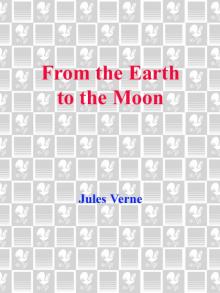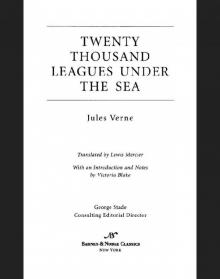- Home
- Jules Verne
From the Earth to the Moon; and, Round the Moon Page 5
From the Earth to the Moon; and, Round the Moon Read online
Page 5
CHAPTER V
THE ROMANCE OF THE MOON
An observer endued with an infinite range of vision, and placedin that unknown center around which the entire world revolves,might have beheld myriads of atoms filling all space during thechaotic epoch of the universe. Little by little, as ages wenton, a change took place; a general law of attraction manifesteditself, to which the hitherto errant atoms became obedient:these atoms combined together chemically according to theiraffinities, formed themselves into molecules, and composed thosenebulous masses with which the depths of the heavens are strewed.These masses became immediately endued with a rotary motionaround their own central point. This center, formed ofindefinite molecules, began to revolve around its own axisduring its gradual condensation; then, following the immutablelaws of mechanics, in proportion as its bulk diminished bycondensation, its rotary motion became accelerated, and thesetwo effects continuing, the result was the formation of oneprincipal star, the center of the nebulous mass.
By attentively watching, the observer would then have perceivedthe other molecules of the mass, following the example of thiscentral star, become likewise condensed by gradually acceleratedrotation, and gravitating round it in the shape of innumerable stars.Thus was formed the _Nebulae_, of which astronomers have reckonedup nearly 5,000.
Among these 5,000 nebulae there is one which has received thename of the Milky Way, and which contains eighteen millions ofstars, each of which has become the center of a solar world.
If the observer had then specially directed his attention to oneof the more humble and less brilliant of these stellar bodies,a star of the fourth class, that which is arrogantly called theSun, all the phenomena to which the formation of the Universe is tobe ascribed would have been successively fulfilled before his eyes.In fact, he would have perceived this sun, as yet in the gaseousstate, and composed of moving molecules, revolving round its axisin order to accomplish its work of concentration. This motion,faithful to the laws of mechanics, would have been acceleratedwith the diminution of its volume; and a moment would have arrivedwhen the centrifugal force would have overpowered the centripetal,which causes the molecules all to tend toward the center.
Another phenomenon would now have passed before the observer'seye, and the molecules situated on the plane of the equator,escaping like a stone from a sling of which the cord hadsuddenly snapped, would have formed around the sun sundryconcentric rings resembling that of Saturn. In their turn,again, these rings of cosmical matter, excited by a rotarymotion about the central mass, would have been broken up anddecomposed into secondary nebulosities, that is to say,into planets. Similarly he would have observed these planetsthrow off one or more rings each, which became the origin of thesecondary bodies which we call satellites.
Thus, then, advancing from atom to molecule, from molecule tonebulous mass, from that to principal star, from star to sun,from sun to planet, and hence to satellite, we have the wholeseries of transformations undergone by the heavenly bodiesduring the first days of the world.
Now, of those attendant bodies which the sun maintains in theirelliptical orbits by the great law of gravitation, some few inturn possess satellites. Uranus has eight, Saturn eight, Jupiterfour, Neptune possibly three, and the Earth one. This last, oneof the least important of the entire solar system, we call theMoon; and it is she whom the daring genius of the Americansprofessed their intention of conquering.
The moon, by her comparative proximity, and the constantlyvarying appearances produced by her several phases, has alwaysoccupied a considerable share of the attention of theinhabitants of the earth.
From the time of Thales of Miletus, in the fifth century B.C.,down to that of Copernicus in the fifteenth and Tycho Brahe inthe sixteenth century A.D., observations have been from time totime carried on with more or less correctness, until in thepresent day the altitudes of the lunar mountains have beendetermined with exactitude. Galileo explained the phenomena ofthe lunar light produced during certain of her phases by theexistence of mountains, to which he assigned a mean altitude of27,000 feet. After him Hevelius, an astronomer of Dantzic,reduced the highest elevations to 15,000 feet; but thecalculations of Riccioli brought them up again to 21,000 feet.
At the close of the eighteenth century Herschel, armed with a powerfultelescope, considerably reduced the preceding measurements.He assigned a height of 11,400 feet to the maximum elevations,and reduced the mean of the different altitudes to little morethan 2,400 feet. But Herschel's calculations were in their turncorrected by the observations of Halley, Nasmyth, Bianchini,Gruithuysen, and others; but it was reserved for the labors ofBoeer and Maedler finally to solve the question. They succeededin measuring 1,905 different elevations, of which six exceed15,000 feet, and twenty-two exceed 14,400 feet. The highestsummit of all towers to a height of 22,606 feet above the surfaceof the lunar disc. At the same period the examination of the moonwas completed. She appeared completely riddled with craters, andher essentially volcanic character was apparent at each observation.By the absence of refraction in the rays of the planets occultedby her we conclude that she is absolutely devoid of an atmosphere.The absence of air entails the absence of water. It became,therefore, manifest that the Selenites, to support life undersuch conditions, must possess a special organization of theirown, must differ remarkably from the inhabitants of the earth.
At length, thanks to modern art, instruments of still higherperfection searched the moon without intermission, not leavinga single point of her surface unexplored; and notwithstandingthat her diameter measures 2,150 miles, her surface equals theone-fifteenth part of that of our globe, and her bulk theone-forty-ninth part of that of the terrestrial spheroid-- notone of her secrets was able to escape the eyes of theastronomers; and these skillful men of science carried to aneven greater degree their prodigious observations.
Thus they remarked that, during full moon, the disc appearedscored in certain parts with white lines; and, during thephases, with black. On prosecuting the study of these withstill greater precision, they succeeded in obtaining an exactaccount of the nature of these lines. They were long and narrowfurrows sunk between parallel ridges, bordering generally uponthe edges of the craters. Their length varied between ten and 100miles, and their width was about 1,600 yards. Astronomers calledthem chasms, but they could not get any further. Whether thesechasms were the dried-up beds of ancient rivers or not they wereunable thoroughly to ascertain.
The Americans, among others, hoped one day or other todetermine this geological question. They also undertook toexamine the true nature of that system of parallel rampartsdiscovered on the moon's surface by Gruithuysen, a learnedprofessor of Munich, who considered them to be "a system offortifications thrown up by the Selenitic engineers." These twopoints, yet obscure, as well as others, no doubt, could not bedefinitely settled except by direct communication with the moon.
Regarding the degree of intensity of its light, there wasnothing more to learn on this point. It was known that it is300,000 times weaker than that of the sun, and that its heat hasno appreciable effect upon the thermometer. As to thephenomenon known as the "ashy light," it is explained naturallyby the effect of the transmission of the solar rays from theearth to the moon, which give the appearance of completeness tothe lunar disc, while it presents itself under the crescent formduring its first and last phases.
Such was the state of knowledge acquired regarding the earth'ssatellite, which the Gun Club undertook to perfect in all itsaspects, cosmographic, geological, political, and moral.

 Michael Strogoff; Or the Courier of the Czar: A Literary Classic
Michael Strogoff; Or the Courier of the Czar: A Literary Classic Voyage au centre de la terre. English
Voyage au centre de la terre. English Journey Through the Impossible
Journey Through the Impossible The Castaways of the Flag
The Castaways of the Flag L'île mystérieuse. English
L'île mystérieuse. English Maître du monde. English
Maître du monde. English Around the World in Eighty Days
Around the World in Eighty Days A Voyage in a Balloon
A Voyage in a Balloon From the Earth to the Moon, Direct in Ninety-Seven Hours and Twenty Minutes: and a Trip Round It
From the Earth to the Moon, Direct in Ninety-Seven Hours and Twenty Minutes: and a Trip Round It Paris in the Twentieth Century
Paris in the Twentieth Century City in the Sahara - Barsac Mission 02
City in the Sahara - Barsac Mission 02 The English at the North Pole
The English at the North Pole The Field of Ice
The Field of Ice From the Earth to the Moon
From the Earth to the Moon Un capitaine de quinze ans. English
Un capitaine de quinze ans. English The Mysterious Island
The Mysterious Island Les indes-noirs. English
Les indes-noirs. English Robur-le-conquerant. English
Robur-le-conquerant. English Propeller Island
Propeller Island Around the World in Eighty Days. Junior Deluxe Edition
Around the World in Eighty Days. Junior Deluxe Edition Les forceurs de blocus. English
Les forceurs de blocus. English In the Year 2889
In the Year 2889 Journey to the Centre of the Earth
Journey to the Centre of the Earth Twenty Thousand Leagues Under the Sea
Twenty Thousand Leagues Under the Sea From the Earth to the Moon; and, Round the Moon
From the Earth to the Moon; and, Round the Moon Vingt mille lieues sous les mers. English
Vingt mille lieues sous les mers. English Cinq semaines en ballon. English
Cinq semaines en ballon. English Twenty Thousand Leagues under the Seas
Twenty Thousand Leagues under the Seas Face au drapeau. English
Face au drapeau. English Michael Strogoff; Or, The Courier of the Czar
Michael Strogoff; Or, The Courier of the Czar Un billet de loterie. English
Un billet de loterie. English The Secret of the Island
The Secret of the Island Off on a Comet! a Journey through Planetary Space
Off on a Comet! a Journey through Planetary Space Into the Niger Bend: Barsac Mission, Part 1
Into the Niger Bend: Barsac Mission, Part 1 All Around the Moon
All Around the Moon A Journey to the Center of the Earth - Jules Verne: Annotated
A Journey to the Center of the Earth - Jules Verne: Annotated 20000 Lieues sous les mers Part 2
20000 Lieues sous les mers Part 2 Robur-le-Conquerant
Robur-le-Conquerant Les Index Noires
Les Index Noires Michael Strogoff; or the Courier of the Czar
Michael Strogoff; or the Courier of the Czar 20000 Lieues sous les mers Part 1
20000 Lieues sous les mers Part 1 Twenty Thousand Leagues Under the Sea (Barnes & Noble Classics Series)
Twenty Thousand Leagues Under the Sea (Barnes & Noble Classics Series) Five Weeks In A Balloon
Five Weeks In A Balloon Journey to the Center of the Earth
Journey to the Center of the Earth 20,000 Leagues Under the Sea
20,000 Leagues Under the Sea Journey to the Center of the Earth (Barnes & Noble Classics Series)
Journey to the Center of the Earth (Barnes & Noble Classics Series) Adrift in the Pacific-Two Years Holiday
Adrift in the Pacific-Two Years Holiday The Collected Works of Jules Verne: 36 Novels and Short Stories (Unexpurgated Edition) (Halcyon Classics)
The Collected Works of Jules Verne: 36 Novels and Short Stories (Unexpurgated Edition) (Halcyon Classics) The Survivors of the Chancellor
The Survivors of the Chancellor Their Island Home
Their Island Home Le Chateau des Carpathes
Le Chateau des Carpathes Les Cinq Cents Millions de la Begum
Les Cinq Cents Millions de la Begum The Floating Island
The Floating Island Cinq Semaines En Ballon
Cinq Semaines En Ballon Autour de la Lune
Autour de la Lune